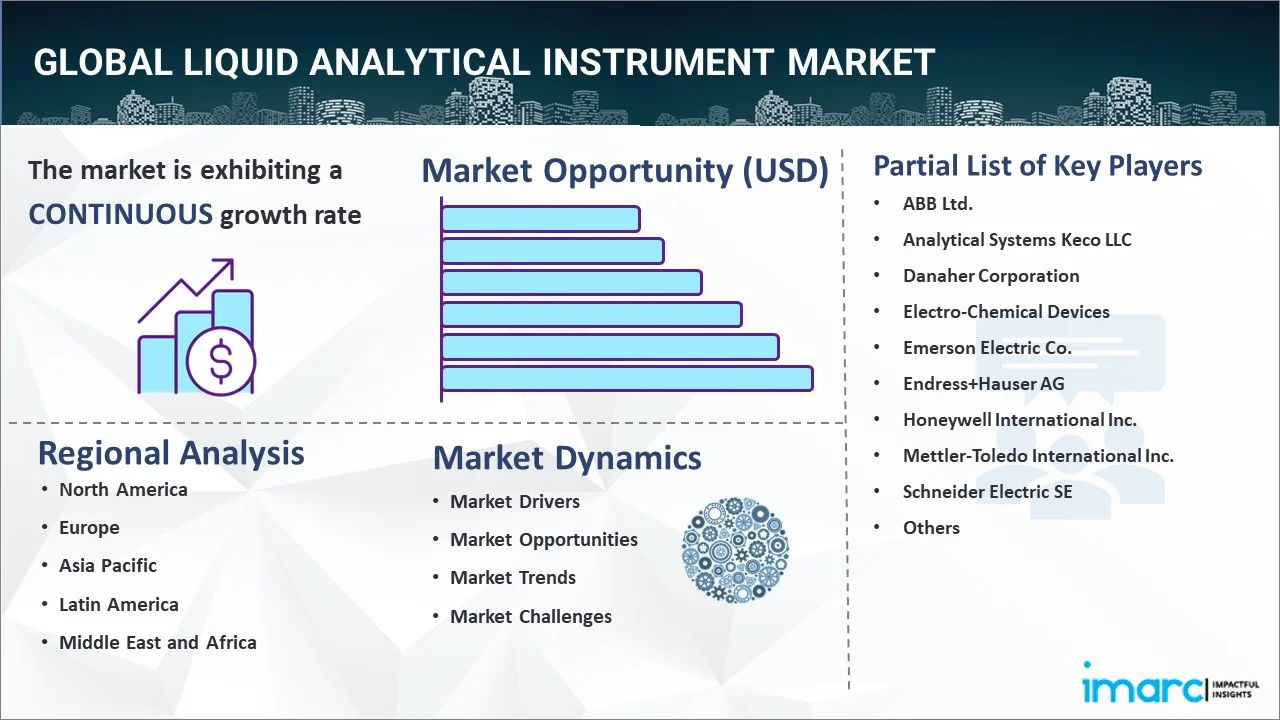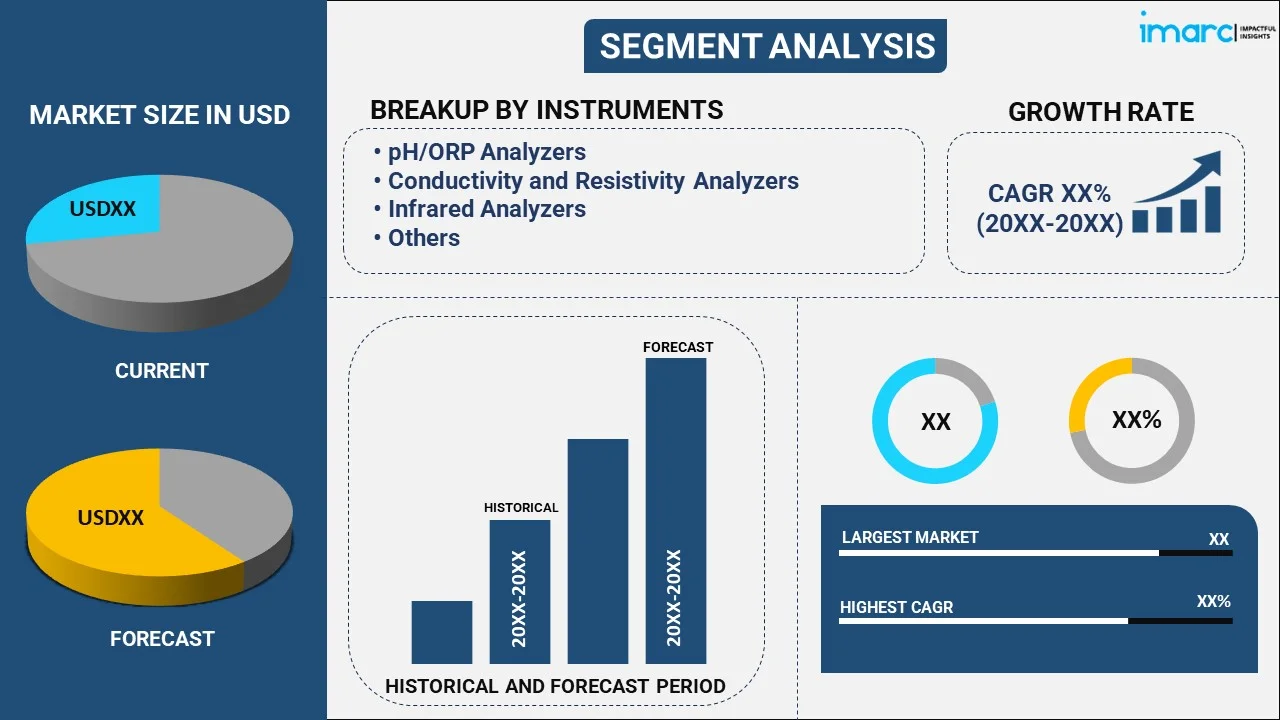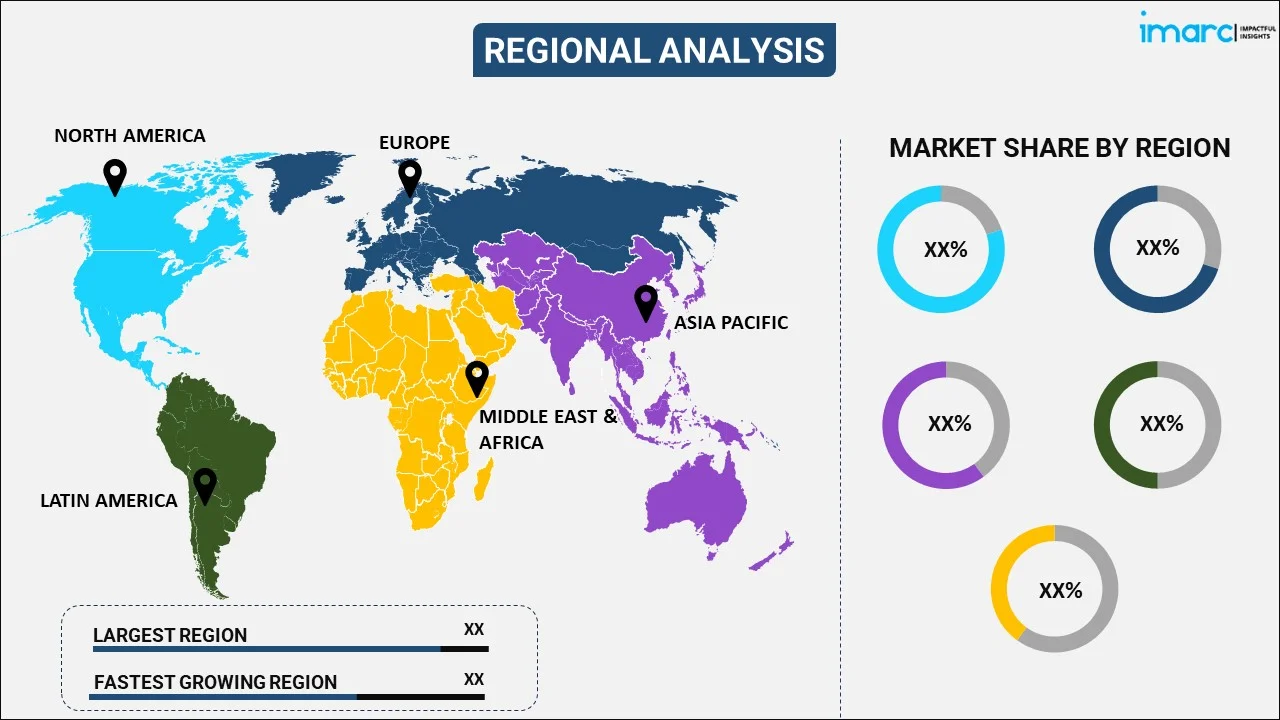
Liquid Analytical Instrument Market Report by Instrument (pH/ORP Analyzers, Conductivity and Resistivity Analyzers, Infrared Analyzers, Oxygen Analyzers, Turbidity Analyzers, and Others), Application (Wastewater Management, Liquid Chemistry Monitoring, Drug Discovery, Water Purification, and Others), End User (Food and Beverage, Chemicals, Energy, Healthcare and Biotechnology, Oil and Gas, Pharmaceuticals, and Others), and Region 2025-2033
Market Overview:
The global liquid analytical instrument market size reached USD 502.1 Million in 2024. Looking forward, IMARC Group expects the market to reach USD 765.2 Million by 2033, exhibiting a growth rate (CAGR) of 4.8% during 2025-2033. The growing environmental concerns and the scarcity of clean water resources, rising demand for application in pharmaceutical sector for maintaining the consistency of chemical formulations, and increasing adoption in the food and beverage (F&B) industry, are some of the factors propelling the market growth.
|
Report Attribute
|
Key Statistics
|
|---|---|
|
Base Year
|
2024 |
|
Forecast Years
|
2025-2033
|
|
Historical Years
|
2019-2024
|
| Market Size in 2024 | USD 502.1 Million |
| Market Forecast in 2033 | USD 765.2 Million |
| Market Growth Rate (2025-2033) | 4.8% |
Liquid analytical instruments are devices used to measure the chemical composition of fluids and evaluate their characteristics of liquids. They aid in monitoring process chemistry, including water quality, providing process optimization and control. They are widely used in several applications, such as the measurement of dissolved oxygen, the potential of hydrogen, conductivity and resistivity of liquids, and oxidation-reduction potential. Liquid analytical instruments help in measuring liquid properties such as pH, ORP, conductivity, dissolved oxygen, chlorine, and turbidity. They also offer various advantages, such as environmental protection, consistent product quality, process optimization, and safety. As a result, liquid analytical instruments find extensive applications across the food and beverage (F&B), chemicals, healthcare, biotechnology, and pharmaceutical industries.

Liquid Analytical Instrument Market Trends:
Increasing Demand for Water and Wastewater Treatment
According to the article published in 2024 by Water.Org, 2.2 billion people globally lack access to safe water. Industries and municipalities are aiming to meet stringent regulations regarding water quality, which is leading to the adoption of liquid analytical instruments for monitoring various parameters like pH, dissolved oxygen, and conductivity. Environmental concerns and the scarcity of clean water resources are encouraging governments and private sectors to invest heavily in advanced water treatment technologies. The increasing use of analytical tools for real-time monitoring helps optimize processes, reduce waste, and maintain compliance with environmental standards. Water-related challenges are becoming more prominent, which is driving the demand for these instruments across various sectors, including industrial manufacturing, agriculture, and municipal water treatment.
Rising Adoption in the Food and Beverage (F&B) Industry
With stricter health regulations and growing consumer demand for transparency in food production, companies are implementing more robust monitoring systems. Analytical instruments help manufacturers monitor factors, such as pH levels, dissolved gases, and chemical composition, ensuring that products meet safety standards and maintain consistency. This is especially critical in processes like fermentation, brewing, and dairy production, where small changes can considerably affect the end product. The push for automation and real-time data collection is also encouraging the adoption of these instruments, as they allow for quicker adjustments during production, improving efficiency and reducing waste. In 2024, Thermo Fisher Scientific launched the Thermo Scientific Dionex Inuvion Ion Chromatography system. This new system supports a broader range of ion chromatography analyses, enhancing lab efficiency and adaptability with advanced pump technology and user-friendly features. It is designed to meet the increasing demand for analyzing environmental contaminants, especially in water, food and beverage (F&B), and oil sectors.
Growing Application in the Pharmaceutical Industry
The pharmaceutical industry requires precise and reliable liquid analytical instruments for a variety of applications, including drug formulation, quality control, and environmental monitoring. The rising demand for pharmaceuticals, driven by the increasing population and the prevalence of chronic diseases, is driving the need for accurate monitoring tools to ensure compliance with stringent safety and quality standards. Instruments like spectrophotometers, titrators, and pH meters are essential in maintaining the consistency of chemical formulations. For instance, the DeNovix DS-8X eight-channel spectrophotometer, launched in 2024, enables rapid UV-Vis analysis of up to eight microvolume samples in about 10 seconds. It is made for measuring nucleic acid and protein levels, providing functions, like adjusting samples in real-time and the choice of GxP compliance for regulated settings. Furthermore, it contains an LED sample tracker to facilitate quick identification during plate readings.
Key Market Segmentation:
IMARC Group provides an analysis of the key trends in each segment of the global liquid analytical instrument market, along with forecasts at the global, regional, and country levels from 2025-2033. Our report has categorized the market based on instrument, application, and end user.
Instrument Insights:

- pH/ORP Analyzers
- Conductivity and Resistivity Analyzers
- Infrared Analyzers
- Oxygen Analyzers
- Turbidity Analyzers
- Others
The report has provided a detailed breakup and analysis of the liquid analytical instrument market based on the instrument. This includes pH/ORP, conductivity and resistivity, infrared, oxygen, turbidity analyzers, and others. According to the report, pH/ORP analyzers represented the largest segment.
Application Insights:
- Wastewater Management
- Liquid Chemistry Monitoring
- Drug Discovery
- Water Purification
- Others
A detailed breakup and analysis of the liquid analytical instrument market based on the application has also been provided in the report. This includes wastewater management, liquid chemistry monitoring, drug discovery, water purification, and others. According to the report, wastewater management accounted for the largest market share.
End User Insights:
- Food and Beverage
- Chemicals
- Energy
- Healthcare and Biotechnology
- Oil and Gas
- Pharmaceuticals
- Others
The report has provided a detailed breakup and analysis of the liquid analytical instrument market based on the end user. This includes food and beverage, chemicals, energy, healthcare and biotechnology, oil and gas, pharmaceuticals, and others. According to the report, food and beverage represented the largest segment.
Regional Insights:

- North America
- United States
- Canada
- Asia Pacific
- China
- Japan
- India
- South Korea
- Australia
- Indonesia
- Others
- Europe
- Germany
- France
- United Kingdom
- Italy
- Spain
- Russia
- Others
- Latin America
- Brazil
- Mexico
- Others
- Middle East and Africa
The report has also provided a comprehensive analysis of all the major regional markets that include North America (the United States and Canada); Asia Pacific (China, Japan, India, South Korea, Australia, Indonesia, and others); Europe (Germany, France, the United Kingdom, Italy, Spain, Russia, and others); Latin America (Brazil, Mexico, and others); and Middle East and Africa. According to the report, North America accounts for the majority of the liquid analytical instrument market share. Some of the factors driving the North America liquid analytical instrument market included the introduction of innovative solutions, widespread product adoption in the biotechnology industry, and rising product demand for inspection of water quality.
Competitive Landscape:
The report has also provided a comprehensive analysis of the competitive landscape in the global liquid analytical instrument market. Detailed profiles of all major companies have also been provided. Some of the companies covered include:
- ABB Ltd.
- Analytical Systems Keco LLC
- Danaher Corporation
- Electro-Chemical Devices
- Emerson Electric Co.
- Endress+Hauser AG
- Honeywell International Inc.
- Mettler-Toledo International Inc.
- Schneider Electric SE
- Teledyne Technologies Incorporated
- Yokogawa Electric Corporation
Kindly note that this only represents a partial list of companies, and the complete list has been provided in the report.
Liquid Analytical Instrument Market News:
- March 2024: Japan's Shimadzu introduced the Nexera FV, an ultra-high performance liquid chromatograph (UHPLC) designed for online analysis. The Nexera FV automates sample collection and injection from manufacturing processes, connecting directly to peripheral equipment like synthesis reactors and dissolution testing machines, streamlining the entire process from sample placement to data acquisition.
- October 2023: Testa Analytical launched its Liquid Chromatography Flowmeter (LCF) for real-time HPLC and uHPLC pump monitoring. The LCF provided continuous, accurate measurement of flow rates, ensuring consistent performance and reproducibility in liquid chromatography. It features a non-invasive thermal flow sensor and allows real-time data monitoring via a PC application, enhancing the reliability of HPLC systems.
Liquid Analytical Instrument Market Report Coverage:
| Report Features | Details |
|---|---|
| Base Year of the Analysis | 2024 |
| Historical Period | 2019-2024 |
| Forecast Period | 2025-2033 |
| Units | Million USD |
| Instruments Covered | pH/ORP Analyzers, Conductivity and Resistivity Analyzers, Infrared Analyzers, Oxygen Analyzers, Turbidity Analyzers, Others |
| Applications Covered | Wastewater Management, Liquid Chemistry Monitoring, Drug Discovery, Water Purification, Others |
| End Users Covered | Food and Beverage, Chemicals, Energy, Healthcare and Biotechnology, Oil and Gas, Pharmaceuticals, Others |
| Regions Covered | Asia Pacific, Europe, North America, Latin America, Middle East and Africa |
| Countries Covered | United States, Canada, Germany, France, United Kingdom, Italy, Spain, Russia, China, Japan, India, South Korea, Australia, Indonesia, Brazil, Mexico |
| Companies Covered | ABB Ltd., Analytical Systems Keco LLC, Danaher Corporation, Electro-Chemical Devices, Emerson Electric Co., Endress+Hauser AG, Honeywell International Inc., Mettler-Toledo International Inc., Schneider Electric SE, Teledyne Technologies Incorporated, Yokogawa Electric Corporation, etc. |
| Customization Scope | 10% Free Customization |
| Post-Sale Analyst Support | 10-12 Weeks |
| Delivery Format | PDF and Excel through Email (We can also provide the editable version of the report in PPT/Word format on special request) |
Key Benefits for Stakeholders:
- IMARC’s liquid analytical instrument market research report offers a comprehensive quantitative analysis of various market segments, historical and current market trends, market forecasts, and dynamics of the market from 2019-2033.
- The research study provides the latest information on the market drivers, challenges, and opportunities in the global liquid analytical instrument market.
- The study maps the leading as well as the fastest growing regional markets. It further enables stakeholders to identify the key country-level markets within each region.
- Porter's five forces analysis assist stakeholders in assessing the impact of new entrants, competitive rivalry, supplier power, buyer power, and the threat of substitution. It helps stakeholders to analyze the level of competition within the liquid analytical instrument industry and its attractiveness.
- Competitive landscape allows stakeholders to understand their competitive environment and provides an insight into the current positions of key players in the market.
Key Questions Answered in This Report
The global liquid analytical instrument market was valued at USD 502.1 Million in 2024.
We expect the global liquid analytical instrument market to exhibit a CAGR of 4.8% during 2025-2033.
The rising demand for liquid analytical instruments across several industries, such as chemicals, healthcare, pharmaceutical, etc., as they offer environmental protection, consistent product quality, process optimization, and safety, is primarily driving the global liquid analytical instrument market.
The sudden outbreak of the COVID-19 pandemic had led to the implementation of stringent lockdown regulations across several nations, resulting in the temporary closure of numerous manufacturing units for liquid analytical instruments.
Based on the instrument, the global liquid analytical instrument market can be segmented into pH/ORP analyzers, conductivity and resistivity analyzers, infrared analyzers, oxygen analyzers, turbidity analyzers, and others. Currently, pH/ORP analyzers hold the majority of the total market share.
Based on the application, the global liquid analytical instrument market has been divided into wastewater management, liquid chemistry monitoring, drug discovery, water purification, and others. Among these, wastewater management currently exhibits a clear dominance in the market.
Based on the end user, the global liquid analytical instrument market can be categorized into food and beverage, chemicals, energy, healthcare and biotechnology, oil and gas, pharmaceuticals, and others. Currently, food and beverage accounts for the largest market share.
On a regional level, the market has been classified into North America, Asia Pacific, Europe, Latin America, and Middle East and Africa, where North America currently dominates the global market.
Some of the major players in the global liquid analytical instrument market include ABB Ltd., Analytical Systems Keco LLC, Danaher Corporation, Electro-Chemical Devices, Emerson Electric Co., Endress+Hauser AG, Honeywell International Inc., Mettler-Toledo International Inc., Schneider Electric SE, Teledyne Technologies Incorporated, Yokogawa Electric Corporation, etc.
Need more help?
- Speak to our experienced analysts for insights on the current market scenarios.
- Include additional segments and countries to customize the report as per your requirement.
- Gain an unparalleled competitive advantage in your domain by understanding how to utilize the report and positively impacting your operations and revenue.
- For further assistance, please connect with our analysts.
 Request Customization
Request Customization
 Speak to an Analyst
Speak to an Analyst
 Request Brochure
Request Brochure
 Inquire Before Buying
Inquire Before Buying




.webp)




.webp)












